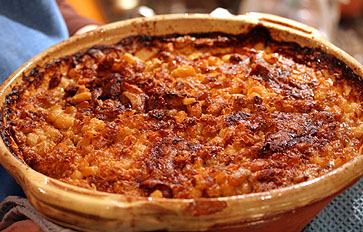FRENCH FOOD
SOME CLASSIC DISHES TO TRY
Sometimes you gain the impression that the whole purpose of France is to enjoy French food, good food, anywhere, any time. As a raison d'être, it probably misses some of the targets set by politicians, but it's not a bad starting point. I never quite feel as though I've arrived back in France until I'm seated beneath a tree, the sun warming my back, and a simple lunchtime plat du jour in front of me with a small pichet of vin rouge. Now I can relax, stop travelling, and ease into the culture of wherever I am.
Here are some excellent regional dishes you may encounter on your travels. Try them all – but not all at once!
Aligot
Aligot is a dish traditionally made in the Aubrac (Aveyron, Cantal, Lozère) region in Massif Central. It is a smooth blend of melted Tomme cheese and mashed potatoes, often flavoured with garlic. This dish dates from the 12th century, and was originally made from bread by monks who prepared it for the pilgrims en route to Santiago de Compostela, but potatoes were substituted after their introduction to France, because they produced a better consistency.
Yes, it's mashed potato, but you ain't had mashed potato like this - just ever so more-ish. Traditionally, it is served with meaty sausages, but if you are in the Aubrac, the home of this dish, then try it with an Aubrac steak - you will not be disappointed.

Making aligot: restaurant size
Andouillette
Andouillette is a tripe sausage of varying sizes, produced both as a mild sausage and as a spicier version.
There are many variations on the theme of andouillette, and their popularity has remained huge for centuries, mainly around Troyes, Lyon, Tours and Orléans, although you can get it as a lunchtime dish virtually anywhere in France.
These sausages can be served hot or cold, and, it must be said, are an acquired taste. The texture is more coarse than conventional sausages. Primarily pan-fried andouillette can also be boiled, barbecued or grilled. The sausage is often served with vegetables in a mustard or red wine sauce. It is best served with dry white wine.
Baeckeoffe
Baeckeoffe is a mix of sliced potatoes, sliced onions, lamb, beef and pork marinated overnight in Alsatian white wine and juniper berries and cooked in a sealed ceramic casserole dish. Leeks, thyme, parsley, garlic, carrots and marjoram are also commonly added ingredients.
In the regional dialect Baeckeoffe means 'baker's oven', and indication of how it was traditionally cooked. Once a week, on washing day (Monday), the women of Alsace would carry their stewpots to the bakery, and then go off to do their laundry. When the baker had finished making bread, he would place these stews in his oven to slow-cook for many hours.
Bouillabaisse
Bouillabaisse is essentially a fish soup containing cooked fish, shellfish and vegetables, flavoured with herbs and spices like garlic, basil, fennel and saffron. Traditionally it originates from Marseille, and no one there will acknowledge a bouillabaisse made anywhere else; it simply won't be bouillabaisse.
Traditionally, there are at least three kinds of fish in bouillabaisse: rascasse (scorpion fish), congre (conger eel) and grondin (sea robin, or mullet). But you are just as likely to find dorade (bream), lotte (monkfish) or merlan (hake). But it is the Provençal herbs and spices that do the trick.
Don't plan to do much for the hours following a bouillabaisse lunch. To begin with, it's a long and gradual experience in itself, and it won't be fully appreciated if you don't allow your digestive system to absorb all the nuances of flavour. Anything more energetic than a digestif is not to be countenanced.

A hearty bowl of cassoulet. © Creative Commons
Cassoulet
This rib-sticking dish is a rich white haricot bean stew containing meat, usually pork sausages, pork and duck confit. It is slow-cooked and best enjoyed at a leisurely pace with plenty of crusty bread, but not at all on a hot day.
There are many regional variations, the best-known being from Castelnaudary, the self-appointed capital of cassoulet. In the cassoulet of Toulouse, the meats are pork and mutton, the latter frequently a cold roast shoulder. The Carcassonne version is similar, but increases the amount of mutton and sometimes replaces the duck with partridge. The cassoulet of Castelnaudary uses a duck confit instead of mutton.
Choucroute
Choucroute, the French form of Sauerkraut is traditionally German, but the annexation of Alsace and Lorraine in 1648 brought this dish to the attention of French chefs.
Fundamentally, there is no fixed recipe for choucroute, it is essentially cabbage, meat and potatoes. But the French have introduced three types of sausage to the dish – Frankfurters, Strasbourg sausage and Montbéliard sausages.
It used to be said that choucroute was what you did to cabbage when you couldn't think of anything worse to do to it – but the French have raised it to culinary greatness, to the extent that you can find it on menus even in Michelin-starred restaurants.
|
The French love foie gras |
|
Foie Gras © Creative Commons |
Ficelle Picarde
Ficelle picarde is a very recent dish in regional gastronomy. It's a thin savoury crêpe rolled around a slice of ham containing finely chopped duxelles mushrooms. Then everything is gratinéed in a cream sauce. It is very well accompanied by a St-Nicolas de Bourgueil, Brouilly or Juliénas.
Foie gras
Foie gras is not to everyone's taste, but that has more to do with the way it is produced – by force feeding (gavage) – than its taste.
The French love foie gras, and will try to get it into everything, but the foie gras crème brulée I was served in Toulouse was just be one step too far.
Even so, everyone should try foie gras at least once; it is tasty when it is well prepared and presented in its original form rather than as a paté.
Gratin Dauphinois
'Gratin' is a culinary technique in which an ingredient is topped with a browned crust, often of breadcrumbs or grated cheese.
The name 'Gratin dauphinois' alludes to the Dauphiné region of France, where the dish is a potato speciality comprising thinly sliced and layered potatoes and cream cooked slowly with garlic. Gratin Savoyarde, from the neighbouring region, also uses layered potato slices, but includes the delicious Beaufort cheese and butter.
Ratatouille
Essentially, ratatouille is a stewed vegetable dish, often served as a side dish, but also as a main course in itself served with pasta or bread, perhaps even with rice. Nor is it unusual to find ratatouille served in crepes or omelettes.
Ratatouille originates around Provence and Nice, where the colours and fragrances of tomatoes, garlic, onions, courgettes. aubergine, peppers, carrot, marjoram and other herbes de Provence combine to create a dish that is as delightful on the olfactory senses as it is on the eye.
Tartiflette
Tartiflette is a dish from Savoie, made with potatoes, Reblochon cheese, cream, and lardons. It often includes onions.
A popular variation of this dish is to substitute smoked salmon for the lardons. The word tartiflette is probably derived from the Arpitan word for potato, tartifla.
This website was built using Site Build It!








